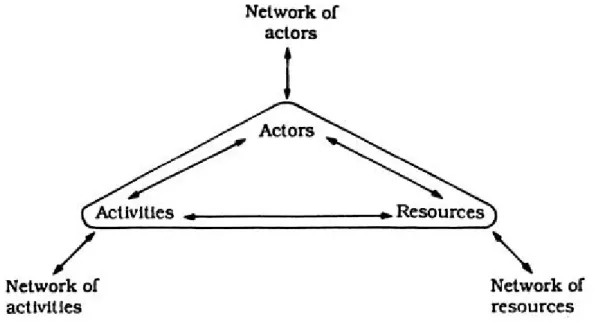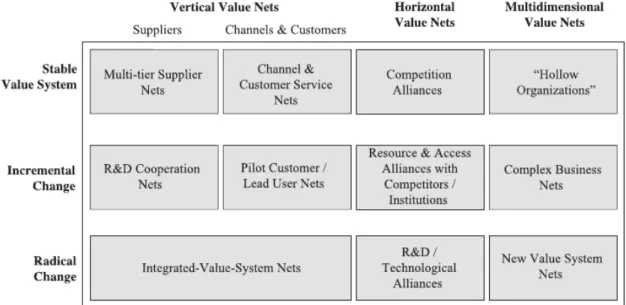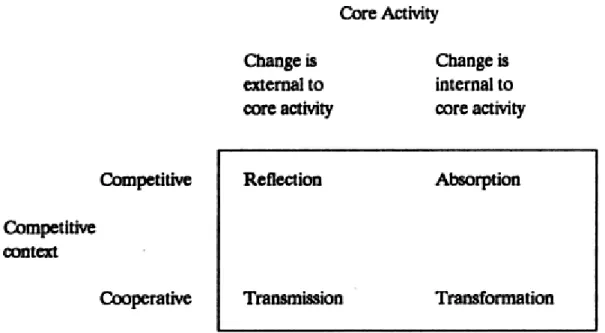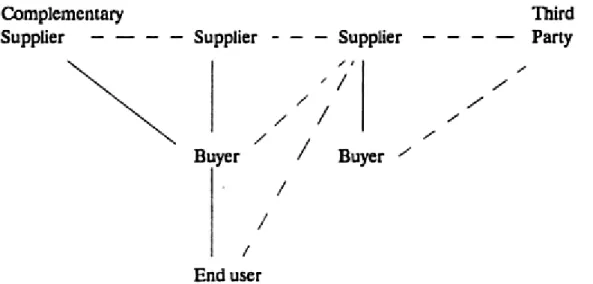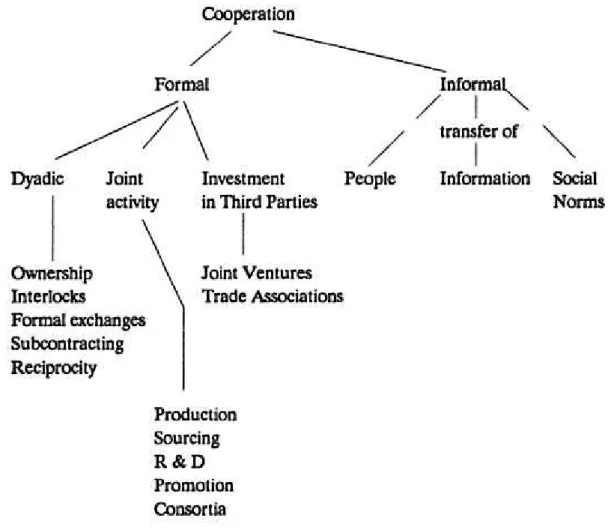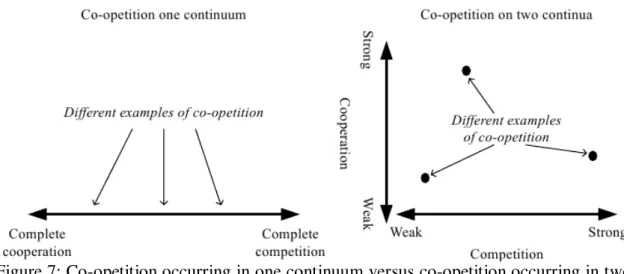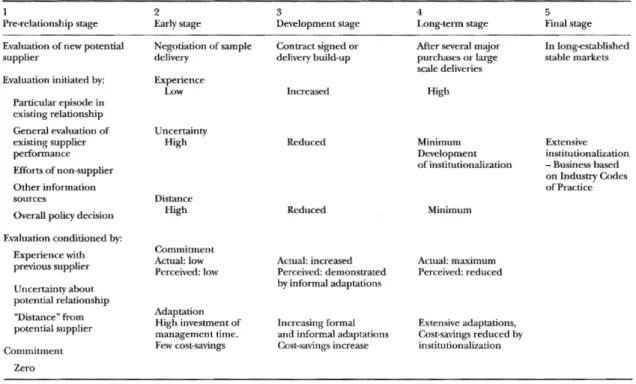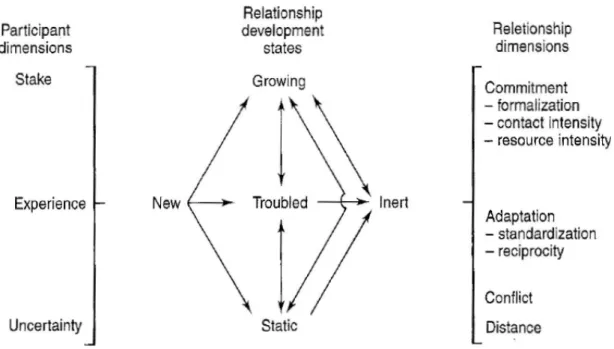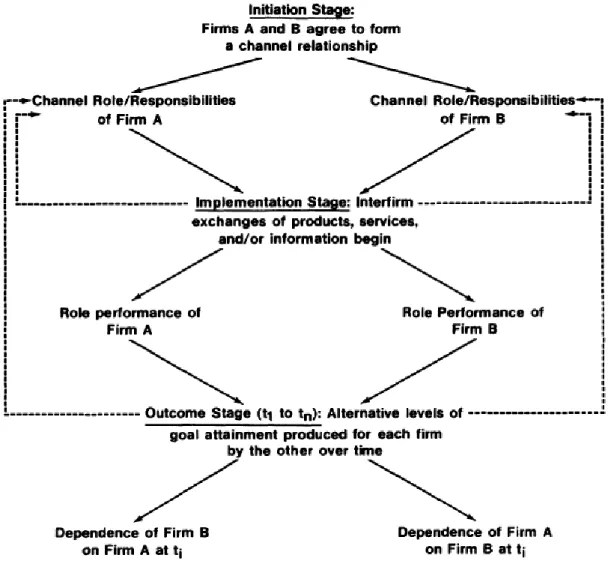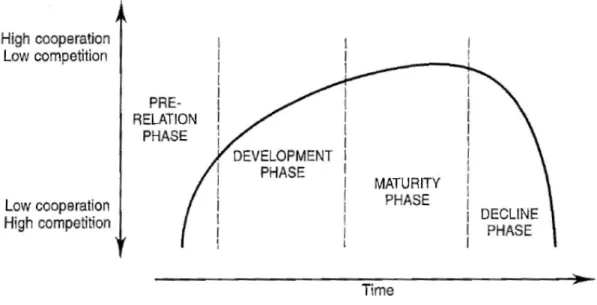ISEG – Instituto Superior de Economia e Gestão
An Interaction and Network Perspective of Horizontal
Relationships in the Portuguese Pharmaceutical Industry
José Manuel Novais de Magalhães Santos
Orientadora: Professora Doutora Maria Cristina de Assis Sales Pinto Baptista
Tese especialmente elaborada para obtenção do grau de Doutor em Gestão
ISEG – Instituto Superior de Economia e Gestão
An Interaction and Network Perspective of Horizontal
Relationships in the Portuguese Pharmaceutical Industry
José Manuel Novais de Magalhães Santos
Orientadora: Professora Doutora Maria Cristina de Assis Sales Pinto Baptista
Tese especialmente elaborada para obtenção do grau de Doutor em Gestão
Júri:
Presidente: Professor Doutor Manuel Fernando Cília de Mira Godinho
Professor Catedrático e Presidente do Conselho Científico do Instituto Superior de Economia e Gestão da Universidade de Lisboa
Vogais: Doutor João Manuel Frias Viegas Proença
Professor Catedrático, Faculdade de Economia da Universidade do Porto Doutor Carlos Henrique Figueiredo e Melo de Brito
Professor Associado, Faculdade de Economia da Universidade do Porto Doutora Maria Catarina de Almeida Roseira
Professora Associada, Faculdade de Economia da Universidade do Porto Doutor Luís Manuel Mota de Castro
Professor Associado, Instituto Superior de Economia e Gestão da Universidade de Lisboa
Doutora Maria Cristina de Assis Sales Pinto Baptista
Professor Auxiliar, Instituto Superior de Economia e Gestão da Universidade de Lisboa
i
Acknowledgements
This thesis was only possible with the support and the contribution of personalities and organizations most kind to have accepted participating in the research. I express my gratitude to all who shared with me their valuable knowledge and offered me their precious time, allowing the research process to reach its conclusion.
First, and foremost, I wish to thank my supervisor, Professor Cristina Baptista, for the constructive discussions she has regularly held with me and that were crucial for the research development. Professor Cristina Baptista has patiently reviewed several consecutive versions of this work and of the associated submitted papers, supporting and motivating me along the whole research endeavour. Her guidance and valuable comments throughout the development of this work were most significant. I genuinely thank you, Professor Cristina.
I am grateful to Professor João Mota for having introduced me to the industrial marketing research and for all the advices regarding the doctoral programme in management, even prior to my application. I also thank Professor Luís Mota de Castro for his contribution to the investigation. Since the first doctoral seminar, the discussions held with Professors João Mota and Professor Luís Mota de Castro were very fruitful for the research development. I also wish to thank Professors Carlos Gouveia Pinto, Jorge Silva e Sousa and Rui Brites for their insights on the pharmaceutical industry, the applicable legislation and the methodology.
ii
Guercini, (discussions during the IMP Journal Seminar), Professors Alexandra Waluszewski and Kristin Munksgaard (discussions during the IMP Doctoral Colloquium) and Professors Lars-Erik Gadde, Luís Araújo, Jan-Åke Törnroos and Milena Ratajczak-Mrozek (discussions during the IMP Conferences). Thank you all for the valuable inputs that allowed me to enhance this research.
I also wish to express my gratitude to all interviewees, from private companies and public bodies, who were open and prompt to contribute to this research. For their time and for the openness in sharing their knowledge with me, I wish to thank Carlos Araujo, Carlos Valadas, Gonçalo Pimpão, Lídia Carvalho, Manuel Sapinho, Manuela Cabugueira, Marco Oliveira, Maria Isolina Mesquita, Maria João Morais, Matilde Dias, Miguel Freudenthal, Miguel Ruas, Paulo Barradas Rebelo, Pedro Ferraz da Costa, Ricardo Soares, Rui Loureiro, Rui Santos Ivo and Thebar Miranda. Your participation was essential for this work to have been possible.
I have been surrounded by amazing friends and a fantastic family. I thank my friends for their support. To my fellow PhD students, in particular Pedro Pimpão, Sara Gonçalves and Vitor Barros, I am grateful for the long motivating discussions that were stoutly of great help to me, specially during this last year. I wish to thank my mother for her love and encouragement, paying the price of scarce visits. My last and warmest recognition goes to my wife, Andreia, who always offered me the motivation to pursue with the investigation and the encouragement to reach the conclusion, reading the manuscript and offering me her acute comments. Thank you, Andreia, for having accompanied me all along this journey. To you, Andreia, I dedicate this work.
iii
Abstract
Horizontal relationships, such as strategic alliances, are of increasing importance and prevalence. The purpose of this research is to understand horizontal relationships’ development within an interaction and network perspective. Significant research has been carried out on strategic alliances, focusing on motivations, antecedents, formation, and outcomes. However researchers have paid far less attention to the developmental processes of these business relationships. To tackle the research objective two complementary conceptual frameworks are considered, one, addressing the interaction and, another, the relationship development.
This research, mainly supported by the industrial marketing and purchasing approach, focuses on: the interaction between competitors, the intercompetitor relationship development and the network effect of such business relationships. It is considered a multiple case study strategy within the Portuguese pharmaceutical industry. Eleven Portuguese pharmaceutical companies with production facilities in-country were identified and all participated in the present research. Nine case studies were purposefully selected, considering the access to both sides of the intercompetitor relationship and the intensive and rich information within. Data was collected mainly through in-depth interviews and complemented by observation and secondary data. The qualitative data was examined adopting the analytical process of compiling, disassembling, reassembling, interpreting and concluding.
Intercompetitor interaction can be characterized along four linked dimensions: context, nature, interaction processes and outcomes. The role of the relationship shared context, coopetition degree (at the company and department levels), information exchange, coordination processes and bond development is strongly related with the interaction and the development of the horizontal relationship. The intercompetitor relationship development may comprise five main phases: co-existence, formation, development, dormant and dissolution. The presence of a catalyst (e.g. government body) triggering the intercompetitor relationship development is denoted. The development of relationships between competitors affects the companies’ negotiation power, the internationalization processes and the public-private relationships development.
iv
Resumo
Os relacionamentos horizontais, como sejam as alianças estratégicas, são cada vez mais importantes e prevalentes. O propósito desta investigação é a compreensão do desenvolvimento de relacionamentos horizontais, utilizando a perspetiva de interação e redes. Foi desenvolvida investigação de relevo em alianças estratégicas salientando as motivações, antecedentes, formação e resultados. Todavia, os investigadores têm vindo a descurar os processos de desenvolvimento destes relacionamentos. Para o objetivo da investigação são considerados dois quadros conceptuais complementares, focando tanto a interação, como o desenvolvimento dos relacionamentos.
É considerada uma estratégia de caso de estudo múltiplo na indústria farmacêutica portuguesa. Foram identificadas onze empresas portuguesas com unidades de produção em Portugal e todas participaram na presente investigação. Nove casos de estudo foram selecionados, considerando o acesso a ambos os lados do relacionamento e a riqueza dos dados recolhidos. Os dados foram obtidos sobretudo em entrevistas aprofundadas e foram complementados com observação e com dados secundários. Os dados qualitativos foram tratados através de um processo analítico que envolve compilação, desagregação, remontagem, interpretação e conclusão.
A interação entre concorrentes pode ser caracterizada através de quatro dimensões: contexto, natureza, processos de interação e resultados. O papel do contexto partilhado, do grau de coopetição (ao nível da empresa e do departamento), da troca de informação, dos processos de coordenação e dos laços criados está fortemente relacionado com a interação e o desenvolvimento do relacionamento horizontal. O desenvolvimento do relacionamento entre concorrentes pode conter cinco fases: co-existência, formação, desenvolvimento, dormência e dissolução. É identificada a presença de um catalisador (e.g. agência governamental) que induz o desenvolvimento do relacionamento entre concorrentes. O desenvolvimento de relacionamentos entre concorrentes afeta o poder de negociação, os processos de internacionalização e o desenvolvimento de relacionamentos público-privados.
v
Contents
Acknowledgements ... i
Abstract ... iii
Resumo ... iv
Figures ... x
Tables ... xiii
List of Symbols and Abbreviations ... xv
Chapter 1 – Thesis Scope and Research Problem ... 1
1.1 Research Motivation ... 1
1.2 Theoretical Background ... 3
1.2.1 Interaction and Network Approach ... 4
1.2.2 Horizontal Relationships as Strategic Alliances... 5
1.3 Research Setting ... 7
1.4 Research Problem and Questions ... 8
1.5 Methodology Overview ... 10
vi
Chapter 2 – Literature Review... 15
2.1 Industrial Network Approach ... 15
2.1.1 Network Structure ... 16
2.1.2 Interdependence within the Network ... 20
2.1.3 Dynamic Aspects of Networks ... 23
2.2 Business Relationships ... 27
2.2.1 The Relationship Nature ... 29
2.2.2 Relationship Development ... 42
2.3 Interaction... 63
2.3.1 Interaction Models ... 65
2.3.2 The Interaction Processes ... 78
2.3.3 The Outcome – The Development of Bonds ... 90
2.4 This Research Conceptual Framework ... 95
2.4.1 Relationship Development Conceptual Framework ... 96
2.4.2 Intercompetitor Interaction Conceptual Framework ... 101
Chapter 3 – Research Methodology ... 109
3.1 Theoretical Paradigms... 109
3.2 Research Approach ... 112
3.3 Research Strategy ... 115
3.3.1 Case Study Research ... 116
vii
3.4 Empirical Research Features ... 120
3.4.1 Time Horizons ... 120
3.4.2 Sampling ... 121
3.4.3 Data Collection ... 125
3.5 Data Analysis... 130
3.5.1 Compiling and Disassembling ... 131
3.5.2 Reassembling, Interpreting and Concluding ... 132
3.6 Research Quality Criteria ... 134
3.6.1 Validity... 135
3.6.2 Generalisability ... 136
3.6.3 Reliability ... 137
3.6.4 Other qualitative research quality criteria ... 138
Chapter 4 – Empirical Research ... 141
4.1 Empirical Setting ... 141
4.1.1 Pharmaceutical Products ... 141
4.1.2 Pharmaceutical Market ... 147
4.1.3 Pharmaceutical Industry ... 152
4.2 Case Studies ... 161
4.2.1 Case One: Firm-Omega & Firm-Iota Relationship ... 162
4.2.2 Case Two: Firm-Rho & Firm-Omega Relationship ... 169
viii
4.2.4 Case Four: Firm-Phi & Firm-Sigma Relationship ... 177
4.2.5 Case Five: Firm-Delta & Firm-Phi Relationship... 184
4.2.6 Case Six: Firm-Kappa & Firm-Delta Relationship ... 189
4.2.7 Case Seven: Firm-Beta & Firm-Kappa Relationship ... 193
4.2.8 Case Eight: Firm-Alpha & Firm-Beta Relationship ... 199
4.2.9 Case Nine: Firm-Zeta & Firm-Alpha Relationship ... 204
Chapter 5 – Data Analysis ... 207
5.1 Analysis at the Embedded Unit Level ... 207
5.1.1 Analysis of the Context ... 208
5.1.2 Analysis of Nature ... 212
5.1.3 Analysis of Interaction Processes ... 215
5.1.4 Analysis of Outcome ... 218
5.1.5 Intertwining of Embedded Unit of Analysis ... 219
5.2 Intercompetitor Relationship Analysis ... 224
5.2.1 Interaction between Competitors ... 224
5.2.2 Intercompetitor Relationship Development ... 227
5.3 Network Effects ... 233
5.3.1 Multiplayer Partnerships ... 234
5.3.2 Public-Private Relationships ... 241
Chapter 6 – Conclusion and Implications ... 245
ix
6.1.1 Intercompetitor Interaction ... 246
6.1.2 Intercompetitor Relationship Development ... 248
6.1.3 Network Effects of Intercompetitor Relationship Development ... 249
6.2 Managerial Contributions ... 251
6.3 Limitations and Future Research ... 252
References ... 255
Appendix A – Interview Guide ... 278
Appendix B – Interviews Detail ... 280
x
Figures
Figure 1: Research overview ... 12
Figure 2: Basic structure of the model ... 16
Figure 3: Types of strategic nets ... 22
Figure 4: Relationships between contexts and change sequences ... 26
Figure 5: Network diagram illustrating non-economic relationships ... 29
Figure 6: Taxonomy of forms of intercompetitor cooperation ... 33
Figure 7: Co-opetition occurring in one continuum versus co-opetition occurring in two separate continua... 37
Figure 8: A model of manufacturer-overseas distributor relationships ... 47
Figure 9: The relationship development process ... 48
Figure 10: The development and maintenance of dependence in a dyadic channel relationship ... 50
Figure 11: A relationship life cycle model ... 52
xi
Figure 13: Revised states model of network relationship development processes showing the difference between the framework according to Western developed model
(shadowed) and the state explored in this research (not shadowed) ... 57
Figure 14: Relationships and interaction in industrial networks ... 64
Figure 15: An illustration of the interaction model ... 65
Figure 16: The nature and scope of supplier-customer interaction ... 66
Figure 17: Buyer-seller interaction model ... 69
Figure 18: Proposed theoretical model ... 70
Figure 19: A framework for assessing marketing’s interaction with another functional area ... 71
Figure 20: Taxonomy of factors in buyer-seller interaction ... 72
Figure 21: Dyadic interaction model ... 73
Figure 22: A synthesis model of buyer-seller relationships ... 74
Figure 23: Standardized path coefficients and t-values for the structural model ... 75
Figure 24: Science-to-business collaborations – A science-to-business marketing approach on scientific knowledge commercialization ... 76
Figure 25: Framework of analysis ... 77
Figure 26: The adaptation process: scale and formality ... 84
Figure 27: Theoretical model for horizontal relationship ... 107
Figure 28: Ontological and epistemological dimensions of realism, CR, MC and relativism ... 111
Figure 29: Reasoning predominance within research phases ... 115
xii
Figure 31: The research and development process ... 143
Figure 32: EU data exclusivity provisions affecting all applications for marketing authorization submitted after 31 October 2005 ... 145
Figure 33: Average price evolution from 2007 to 2013 in non-hospital market ... 152
Figure 34: The pharmaceutical industry’s value curve ... 153
Figure 35: Production process – example ... 163
Figure 36: Empirical model of analysis for the intercompetitor interaction: 4 dimensions ... 225
Figure 37: Empirical model of analysis for the intercompetitor interaction: 3+1 dimensions ... 226
Figure 38: Phases of the intercompetitor relationship development ... 228
Figure 39: Intercompetitor relationship phases within multiplayer partnerships ... 232
Figure 40: Partnership structure – internationalization ... 235
xiii
Tables
Table 1: The development of buyer-seller relationships in industrial markets – summary
... 45
Table 2: Contrasting the marriage and dance metaphors ... 53
Table 3: Relationship development models – summary ... 60
Table 4: Adaptation type - Summary ... 85
Table 5: Context characteristics from previous studies ... 103
Table 6: Interaction processes characteristics from previous studies ... 105
Table 7: Bonds characteristics from previous studies... 106
Table 8: Comparison of different views... 110
Table 9: Case study tactics for four design tests ... 138
Table 10: Eight “Big-Tent” criteria for excellent qualitative research ... 139
Table 11: Quality criteria – procedures summary ... 140
Table 12: Pharmaceutical market value (at ex-factory prices) in Europe ... 148
Table 13: Detailed pharmaceutical market value in Portugal ... 150
xiv
Table 15: Pharmaceutical industry research and development in Europe ... 155
Table 16: Parties context summary ... 209
Table 17: Shared context summary ... 210
Table 18: Relationship nature summary ... 212
Table 19: Interaction processes summary ... 215
Table 20: Relationship outcome summary ... 218
Table 21: Intertwining of embedded units of analysis summary... 222
xv
List of Symbols and Abbreviations
AICEP – Trade & Investment Agency API – Active Principal Ingredients
APIFARMA – Portuguese Pharmaceutical Industry Association ARA – Activities, Resources, Actors
COM – European Commission Communication CPhI – Convention on Pharmaceutical Ingredients CR – Critical Realism
EEC – European Economic Community
EGA – European Generic and Biosimilar medicines Association
EFPIA – European Federation of Pharmaceutical Industries and Associations EMA – European Medicines Agency
EU – European Union
xvi
IFPMA – International Federation of Pharmaceutical Manufacturers and Associations IMP – Industrial Marketing and Purchasing
IMS – IMS Health INE – Statistics Portugal
INFARMED – National Authority of Medicines and Health Products, IP KAM – Key Account Manager
MC – Moderated Constructivism NME – New Molecular Entity OTC – Over-the-counter
PhRMA – Pharmaceutical Research and Manufacturers of America R&D – Research and Development
SNS – National Health System
SPC – Supplementary Protection Certificate UK – United Kingdom
1
Chapter 1 – Thesis Scope and Research Problem
This thesis research aims at improving the knowledge of horizontal relationships, particularly the intercompetitor relationship development and the interaction held between competitors. The industrial marketing and purchasing (IMP) approach deeply researches business relationships, focusing, specially, on buyer-seller relationships. It is widely argued that the industrial network approach is the one that best tackles the complexity of this phenomenon. This introductory chapter briefly presents the theory sustaining this thesis development, the specific relationships addressed, the research setting, the research problem and associated questions, methodology overview and, finally, the whole structure of the thesis.
1.1 Research Motivation
2
(Riccobono, Bruccoleri, Harrigan, & Perrone, 2014). Belderbos, Carree, Diederen, Lokshin, and Veugelers (2004) consider the heterogeneity in R&D cooperation and adopt three different types of cooperation: horizontal (with competitors), vertical (with suppliers or customers) and institutional (with universities or research institutes).
Strategic alliances between competitors are of increasing importance and prevalence (Hitt, Dacin, Levitas, Arregle, & Borza, 2000; Leischnig, Geigenmueller, & Lohmann, 2014; N. Li, Boulding, & Staelin, 2010; Luo, Rindfleisch, & Tse, 2007; Shah & Swaminathan, 2008; Sluyts et al., 2011; Wallenburg & Schäffler, 2014; Wu, 2014). Cooperative relationships between competitors can be joint ventures, licensing, coproduction agreements, joint research programs and exploration consortia, among others (Contractor & Lorange, 1988). Strategic alliances are inter-company and cooperative long-term agreements carried out with the aim of capturing a mutual economic benefit (Gulati, Nohria, & Zaheer, 2000; Inkpen, 2001). Strategic alliances are usually formed to explore mutually compatible interests and goals (Mӧller & Halinen, 1999; Webster, 1992) and to enhance individual competitiveness (Webster, 1992). Strategic alliances can involve partnerships with real or potential competitors, as well as with customers or resellers (Webster, 1992). “They can occur as a result of a wide range of motives and goals, take a variety of forms, and occur across vertical and horizontal boundaries” (Gulati, 1998, p. 293).
3
Further, the research on strategic alliances typically focuses on the organization and not on the horizontal relationship, nor on the interaction that takes place between partners. By having the firm as an unit of analysis, researchers do not take into account the actions of other firms or the relationships in which firms are embedded. Thus, research on strategic alliances can represent an under-socialized account of the firm behaviour (Gulati, 1998). Most marketing and strategy management models assume that actors are independent units with well-defined boundaries, have high level of control over their actions and goals, act within a faceless and purely competitive environment, perform isolated transaction episodes with other actors and have no influence over each other. However, contemporary empirical observations show that organizations are not independent, actor’s control is limited, organization boundaries are blurred (e.g. due to alliances), actors can influence each other in relationships and have incomplete and partial knowledge (Axelsson, 1992; Easton, 1992; Ford & Håkansson, 2006; Håkansson, Harrison, & Waluszewski, 2004; Håkansson & Snehota, 2006).
The present research addresses the existing gap in the literature regarding the development of intercompetitor relationships. It focuses on the interaction held between competitors and considers the intercompetitor relationship within its context. Although strategic alliances have gained much attention in previous research, the IMP approach (Håkansson, Snehota, Ford, Cunningham, & Hallen, 1982; Håkansson & Snehota, 2006) shed important light on the dynamics of horizontal relationships by focusing on the interaction between competitors. Furthermore, it is argued that the network and interaction approach could and should be used to tackle this phenomenon (Santos & Baptista, 2015).
1.2 Theoretical Background
4 1.2.1 Interaction and Network Approach
The Industrial Network Approach has its genesis on empirical studies of dyadic relationships in industrial markets, internationalization and distribution channels and it has cross references with other network approaches, such as social exchange theory or social networks. At the beginning, it was classified as interaction approach and, dealt with the development and institutionalization of economic exchange relationships between industrial companies. The scope of the industrial networks approach has further been enlarged to encompass all forms of interactions and relationships in organization markets (Araujo & Easton, 1996).
Dubois and Araujo (2004) argue that, in contrast with the traditional industrial marketing, the first IMP project: (1) focused on the business relationship between buyers and sellers, instead of studying single discrete purchases, (2) examined interaction between buyers and sellers and not the marketing mix variables, (3) highlighted the stability of industrial markets, as an alternative to atomistic structure with many buyers and sellers, and (4) analyzed both buyers and sellers, instead of the separation of marketing and purchasing.
Interaction is regarded to be the essence of intercompany relationships (Håkansson et al., 1982). It entails reciprocal behaviour between at least two actors involved in the relationship. Exchange is always present, in the form of transfer of a product, service, communication, comprising both intangible (e.g., social, psychological) and tangible entities (Bagozzi, 1975). In other words and focusing on the interaction processes, “a business relationship consists of a serially interdependent pattern of episodes institutionalized in patterns and processes of mutually specialized adaptations” (Dubois & Araujo, 2004, p. 214).
5
In each relationship, Anderson, Håkansson, and Johanson (1994) distinguish two different functions, the main one and the secondary one, being this later precisely the network function. The main function, created by the interaction between two companies, can generate positive effects (e.g. learning, cooperation, adaptation), as well as negative ones (e.g. incompatibility), in both companies directly involved in that relationship. The secondary function is created by the existence of connections among all the existent relationships and involves more than just the two companies. The organization’s participation in a given relationship has an impact on other relationships of the same organization (Anderson et al., 1994). That is, “when any resources or activities are shared between relationships there will be either a positive or a negative connection between them” (Håkansson & Ford, 2002, p. 134).
In the same line of thought, Easton (1992) identifies two reasons that drive firms to enter and develop relationships. First, complementarities can be exploited in order to enhance effectiveness through adaptations, knowledge and stability. Second, firms may exploit network access, as network grants firms a participation in third parties resources, like information, or as it also mobilizes against opponent third parties.
Firm’s embeddedness in a competitive environment forced traditional markets to change towards networks (Mӧller & Halinen, 1999; Mӧller, Rajala, & Svahn, 2005). The development of a network-like market exchange facilitates production costs reduction and increases innovation or technical development (Håkansson & Ford, 2002; Håkansson et al., 2004). When compared to traditional markets and hierarchical organizations, networks can provide firms with superior knowledge access (Håkansson & Ford, 2002; Mӧller et al., 2005). Networks also provide limitations, e.g. dependence on approval to change (Håkansson & Ford, 2002).
1.2.2 Horizontal Relationships as Strategic Alliances
6
conducted on relationships between competitors in horizontal settings” (Bengtsson et al., 2003, p. 2).
Cooperative intercompetitor relationships within networks are less evident, i.e. more informal and invisible (Bengtsson & Kock, 1999; Easton & Araujo, 1992; Easton, 1992). Economic transactions confer visibility to a relationship, the reason why economic exchange relationships are easier to recognize than relationships not of that type. Horizontal relationships are built mainly on information and social exchanges and do not involve economic exchanges (Bengtsson & Kock, 1999; Easton & Araujo, 1992). Intercompetitor relationships often involve strategic alliances (Contractor & Lorange, 1988), as a formal or informal agreement, built on trust, mutual interests and social norms (Bengtsson et al., 2003; Bengtsson & Kock, 1999). Cooperative relationships between competitors “are built on a mutual interest to act in cooperation as the interaction in both cases gives access to external resources and knowledge needed by the competitors involved in the relationship” (Bengtsson et al., 2003, p. 4).
An alliance is established when two or more entities mutually appraise collaboration as being beneficial. Both the organizational objectives and the external opportunities determine the formation of the alliance (Mitsuhashi & Greve, 2009). Dacin, Oliver, and Roy (2007) identify several authors who point out the benefits attributed to the strategic alliances, namely, being a tool for entry in new markets, increased market power, acquisition and exchange of skills, achievement of strategic renewal, management of risk and investment, attainment of economies of scale and of scope, realization of reductions in liabilities of foreignness and accomplishment of institutional legitimacy. Complementary technologies may as well be behind the formation of alliances (Forsgren & Johanson, 1992a). Besser and Miller (2011) emphasize also that formal alliances involving independent companies, formed to promote the success of their members, are generally accepted as an important strategic support for the small businesses development in a regional economy.
7
or resources. Many companies already own resources that sustain a competitive advantage, but to compete in some specific markets they may require additional resources (Inkpen, 2001).
Cooperation activity is performed within a dyadic business relationship and is part of the interaction between two actors. Cooperation and cooperative relationships “have been at the core of the discussion in research on strategic alliances” (Håkansson & Prenkert, 2004, p. 85). The development and maintenance of a strategic relationship can have a positive or negative impact on current and future relationships, usually produces long-term effects (Mӧller & Halinen, 1999; Mӧller et al., 2005) and may require considerable resources, leading to low or even negative direct revenue (Mӧller & Halinen, 1999).
Despite several benefits to companies derived from developing partnering relationships with customers, suppliers and other possible allies, limitations and disadvantages can also arise from relationships. Håkansson and Snehota (1995b) identified five negative effects: unruliness (the loss of control), undeterminedness (the uncertain bet), energy (resource demanding), exclusiveness (the preclusion of others) and stickiness (requests are unexpected regarding both their origin and timing). The decision to form an alliance is, in itself, critical (Hitt et al., 2000). Biong, Wathne, and Parvatiyar (1997) concluded that when companies do not want to engage in partnering relationships it is due to fear of dependency, lack of perceived value in the relationship, lack of credible partners, lack of relational orientation in the buying company and rapid technological changes.
1.3 Research Setting
8
This research addresses horizontal relationships in the Portuguese pharmaceutical industry. Within the Portuguese pharmaceutical industry there are two major alliances that gather medicine producers: PharmaPortugal and ISO Project. Companies involve themselves in these multiplayer alliances with their competitors to improve internationalization, to pool know-how, to increase medicine exports, to boost effectiveness and to strengthen negotiation power, among others.
Horizontal partnerships usually involve several companies (cf. Wallenburg & Schäffler, 2014), holding numerous intercompetitor relationships. This study centres its attention on the relationships between Portuguese pharmaceutical companies with production facilities in Portugal that are members of the above-mentioned alliances. At the beginning of this research, eleven companies were identified to form the population of Portuguese pharmaceutical companies with production facilities in Portugal. All were invited to participate in the present study and all those companies have accepted the invitation and have participated.
1.4 Research Problem and Questions
9
The present research also takes the network perspective into consideration by viewing intercompetitor relationships in a broader network of business relationships. The industrial networks approach encompasses all forms of interactions and relationships (Araujo & Easton, 1996). Within the network, each actor develops relationships with customers, suppliers, distributors, competitors, complementary suppliers, universities, trade and professional associations, government bodies and consultants (Easton & Araujo, 1992). Gebrekidan and Awuah (2002) argue that there is a lack of empirical studies addressing the link between network actors and the achievement of goals pursued by strategic alliance partners. This research regards network effects of intercompetitor relationship development (e.g. public-private relationships development) and multiplayer alliances, that are also seen as a whole.
Deepening the knowledge on the intercompetitor relationship development also contributes to pursuing the research on strategic alliances, specifically, on the alliance management and performance. Strategic alliances are frequently described as being unstable and leaning towards failure. Studies show that 50 percent of strategic alliances have high levels of instability and one or both partners consider it a failure (Inkpen, 2001). Strategic alliance termination is frequently studied to evaluate alliance’s performance. However, alliance termination studies “fail to distinguish between natural and untimely deaths” and “not all ongoing alliances are necessarily successful” (Gulati, 1998, p. 307). Enhanced understanding of intercompetitor interaction offers insightful managerial implications, such as, improving access to strategic alliance’s benefits. The research problem of this thesis has been defined as “to understand the development of horizontal relationships within the interaction and network perspective in the Portuguese pharmaceutical industry”. In other words, the aim is to study intercompetitor relationships in the Portuguese pharmaceutical industry by answering the following research questions:
1. How can horizontal relationships be characterized within the interaction and relationship framework?
2. How do industrial horizontal relationships develop in a multiplayer alliance context?
10
The research problem presented is based on the assumption that strategic alliances understanding can be enhanced when one takes into consideration both the interaction between partners and the industrial network in which firms are embedded. Several approaches are employed, individually or combined, to examine horizontal relationships: dynamic capabilities view (e.g. Rocha-Gonçalves & Gonçalves, 2011), management control theory (e.g. Shah & Swaminathan, 2008), organizational learning (e.g. Doz, 1996; Lavie et al., 2010), social networks (e.g. Gulati, 1998), real option theory and transaction cost theory (e.g. Folta, 1998), relational network theory and agency theory (e.g. Meuleman et al., 2010), resource-based view (e.g. Das & Teng, 2000), resource-based view and dynamic capabilities-based view (e.g. Jiang et al., 2010), resource-based view and organizational learning (e.g. Hitt et al., 2000), transaction cost economics, knowledge-based view and real options theory (e.g. N. Li et al., 2010).Yet, they do not frequently use the industrial networks perspective (Bengtsson & Kock, 1999).
1.5 Methodology Overview
As stated, the focus of this research is on the understanding of horizontal relationship development in the context of the pharmaceutical industry, not on the frequency of the phenomenon (cf. Easton, 1995). Thus, this research aims at constructing context-related theory by starting a theory supported analysis and reaching an empirically grounded model. It develops a multiple case study, supported on the foundations of moderate constructionism (cf. Järvensivu & Tӧrnroos, 2010; Van Den Belt, 2003) and abduction (cf. Dubois & Gadde, 2002; Järvensivu & Tӧrnroos, 2010; Sæther, 1998; Van de Ven, 2007).
11
parallels the connectedness and dynamic processes that are at the heart of industrial networks” (Dubois & Araujo, 2004, p. 210).
The research was carried out as follows. First, the researcher proposed two theoretical models, one addressing the horizontal relationship development (Santos & Baptista, 2014) and the other the intercompetitor interaction (Santos & Baptista, 2015). Both tentative models were created via conceptual analysis, using the existing literature and a preliminary knowledge of the context. The prior development of theoretical models in case study research benefits data collection and analysis (Aaboen, Dubois, & Lind, 2012; Yin, 2009). Further, “a priori specification of constructs can also help to shape the initial design of theory-building research... If these constructs prove important as the study progresses, then researchers have a firmer empirical grounding for the emergent theory” (Eisenhardt, 1989, p. 536).
12 Figure 1: Research overview
13
1.6 Structure of the Thesis
Chapter one, in which this section is inserted, presents the importance of the research theme, i.e. the development of the intercompetitor relationship. It defines the problem and the questions that will be addressed throughout the whole of the remaining thesis. The current chapter also introduces the theoretical background, the empirical context and the research methodology.
The second chapter centres its attention on the interaction and network approach. The presented literature review provided both the frame and the theoretical bases that sustain the investigation theme, while supporting also the formulation and the delimitation of the research. The literature review on the IMP approach helped to generate and define research ideas, granted awareness, both of the current knowledge and of the limitations on the subject under study. The primary focus is the intercompetitor interaction and relationship development. Yet, this chapter also includes network considerations. At the end of chapter two is presented the developed conceptual framework that focus mainly on the relationship development and on the interaction between actors.
Chapter three addresses the methodological aspects of the research, from the very beginning to the final write-up of the thesis. It holds ontological, epistemological research strategy considerations. Further, it comprises descriptions of time horizons, sampling and data collection, as well as it depicts data analysis and research quality criteria.
In chapter four, a description of the empirical study is offered. Hence, the empirical setting, i.e. the pharmaceutical industry context (in particular the Portuguese context) is presented, followed by a description of the nine case studies, each one addressing one intercompetitor relationship. Each case is portrayed considering the four building blocks of the conceptual model that addresses the intercompetitor interaction.
14
15
Chapter 2 – Literature Review
This chapter presents a literature review focusing mainly on the industrial network and interaction approach. Two major conceptual frameworks, the interaction model and the ARA model, support the industrial network and interaction approach (Cova, Pardo, Salle, & Spencer, 2014). Addressing essentially the interaction between parties and the relationship development, this chapter starts by encompassing theoretical considerations on the network. Herein are presented four main blocks that address respectively the network, the relationship, the interaction and finally this study conceptual framework.
2.1 Industrial Network Approach
Business relationships imply the existence of a structure that Håkansson and Snehota classified as being a network (Araujo & Easton, 1996). Via direct relationships, network actors establish indirect relationships (Easton & Araujo, 1992). The network structure is represented by an actor’s interaction episodes and is the compound result of all his relationships. This network structure is constantly updated according to the interactions undertaken by players who form the network (Araujo & Easton, 1996). The network emerges and develops as a consequence of interaction between companies (Håkansson & Johansson, 1988) and affects and is affected by the interaction between actors (Lundgren, 1992).
16
commercial actors, such as, customers, suppliers and competitors, but also by relationships with noncommercial actors, such as government agencies or universities (Mӧller & Halinen, 1999). Thus, “each firm in the network has relationships with customers, distributors, suppliers, etc. (and sometimes also directly with competitors), plus indirect relations, via those firms, with the suppliers’ suppliers, the customers’ customers, competitors, and others” (Johanson & Mattsson, 1987, p. 35).
2.1.1 Network Structure
Actors are interrelated in the network structure by their performed activities, controlled resources and social circumstances (Lundgren, 1992). “Resources, activities and actors constitute the basic building blocks in the network approach” (Lundgren, 1992, p. 149). Through relationships, each element (actors, activities and resources) forms structures that can be described as networks (Håkansson & Johanson, 1992).
Håkansson and Johanson (1992) outlined a model of industrial networks where actors, activities and resources are basic elements of its structure. The model is represented in Figure 2.
Figure 2: Basic structure of the model
17
Actors can be individuals, groups of individuals, parts of firms, entire firms or groups of firms that perform activities and/or control resources. Resources are controlled by one or several actors and each actor has different perceptions about the control over a certain resource. Activities are based on resources. “An activity occurs when one or several actors combine, develop, exchange, or create resources by utilizing other resources” (Håkansson & Johanson, 1992, p. 30).
“All firms are simultaneously involved in the ongoing management of the network, and the resulting structure and performance is coproduced by their actions” (Ritter, Wilkinson, & Johnston, 2004, p. 177). The actor’s capability to understand the network, i.e. to recognize structure, processes and evolution of the network, to be aware of its position and credibility, is of utmost importance to influence the other network actor’s beliefs, goals and behaviours (Mӧller & Halinen, 1999; Mӧller et al., 2005). Network relationships affect the nature and outcome of the organizations’ effectiveness (Gadde, Huemer, & Håkansson, 2003).
Goals and efforts of the actor to improve his position in the network lead to a dynamic structure that is dependent on the past and existing structure and that never reaches a final stage of equilibrium (Ford & Håkansson, 2012). The position in the dyadic relationship is determined by the role, importance and strength of the relationship. The position in the network is affected both by direct and indirect relationships. A position change is not easy to implement, but when accomplished it will impact, to a greater or lesser extent, the position of the other network firms (Easton, 1992). Network positions of all actors are continuously questioned, requiring each one to have the strength and the capacity correspondent to one’s position (Håkansson & Johansson, 1988).
18
Demonstrate to others that a firm is cooperating with central network actors can provide centrality and power. Visibility can be more important than the stated purpose of the cooperation and formality may play a significant role. Through formalization, parties demonstrate the presence of the counterpart, signalling other actors. Such messages can be addressed to distributors, suppliers, customers, competitors, consultants and public authorities (Håkansson & Johansson, 1988).
“Companies do things, they perform various activities, develop products, produce and process information, purchase and sell” (Håkansson & Snehota, 1995a, p. 50). Activities are cumulative processes that take time and entail investments (Axelsson, 1992), that are never definitive or unchangeable and that can be integrated (several into one), or divided (one into several) (Håkansson, 1992).
Individual organizations’ activities and the ones of a number of counterparts are interdependent forming chains of activities (Gadde et al., 2003). Thus, “activities are often dependent on the successful execution of a prior activity” (Thunman, 1992, p. 72). The opportunity to link activities with the ones of other organizations provides gains in productivity and in efficiency. “Strategizing in the activity dimension is also about trying to influence the activities of others. Coordinating activities spanning the boundaries of firms is to a large extent a matter of mutual influence” (Gadde et al., 2003, p. 361). Activities are pursued by the actors taking into account the specific objectives of each one of the actors involved (Håkansson & Snehota, 2006).
Companies are closely interrelated through activity links and resource ties (Håkansson & Snehota, 1995a; Mӧller et al., 2005). “Actors have differential knowledge about activities, resources and other actors in the network” (Håkansson & Johanson, 1992, p. 30). Over time, actors’ knowledge on how to combine resources to perform activities evolves (Lundgren, 1992). A change (or potential change) considered by an actor will affect one or more activities and/or resources. Other actors in the network will consider the impact of that change on their relative position vis-à-vis other network actors (Gadde & Håkansson, 1992).
19
negative when they are substitutes. Yet, resources’ properties may change over time, e.g. through the actor’s experience they can be used, combined and transformed in different ways. Resources are used to establish, maintain and develop relationships over time (Johanson & Mattsson, 1992).
“Through relationship either party can gain access to the other’s resources” (Håkansson & Snehota, 2006, p. 260). Actors can therefore access resources controlled by other actors in the network (Ford & Håkansson, 2006; Johanson & Mattsson, 1992). Considering that “a significant part of a company’s total resource base is located beyond its ownership boundary and is controlled bilaterally with other firms” (Gadde et al., 2003, p. 359). Relationships with other actors represent an important resource in itself (Gadde et al., 2003).
Developing deep relationships enhances the resources they provide, but requires substantial investments and is costly to handle, which limits the enlargement of other potential deep relationships. This locked-in relation with another actor does not mean stagnation, the relationship evolves and changes do happen, based on what is suggested or implemented by both partners (Gadde et al., 2003). Relationships development increases firm’s dependence and leads to a reduction in its own resources. Dependency evolves over time and firms can benefit from an efficiency increase (both in resources and knowledge), an improvement of operation predictability and a reduction of both research costs and decisions frequency (Ford & Håkansson, 2006).
20 2.1.2 Interdependence within the Network
The structure of organizational relationships creates a complex set of interdependence (Håkansson & Snehota, 2006). Network interdependencies exist in the dyadic relationship, as well as in other relationships connected to the dyad (Hertz, 1992). “Business in one relationship is often conditioned by relationships with third parties, such as the customer’s customers, the supplier’s suppliers, consultants, competitors, supplementary suppliers, middlemen, as well as public or semi-public agencies” (Forsgren & Johanson, 1992a, p. 5).
The interdependencies existing between actors are an intrinsic characteristic of business networks (Ford & Mouzas, 2008). In other words, interdependencies between relationships in business markets form an interdependent network-like structure (Snehota, 2004). Companies are connected through direct and indirect relationships and their activities must be coordinated, due to their mutual dependence (Johanson & Mattsson, 1987). “Activities within one party are connected with activities carried out in the other” (Håkansson & Snehota, 2006, p. 260). The close relation between resources and activities implies that activity change leads to resource change and vice versa (Håkansson, 1992). The evolution of interdependencies between activities modifies actors’ specialization level. Thus, specialization is one effect of interaction over time in the structure of activities (Ford & Håkansson, 2012).
Specialization, on its turn, increases interdependencies, leading two business units to combine their two sets of resources with the goal of increasing effectiveness and revenues, i.e. two business units collaborate due to specific resource dependencies. Through cooperation one business unit can get access to resources of the other, improving over time the resource utilization (Håkansson & Prenkert, 2004). Relationships are assets with their own resources, requiring investment in the present, but only providing return in the future. They lead to interdependence between firms (Ford & Håkansson, 2006).
21
of the surrounding network (Ritter & Ford, 2004). Actors’ interaction will be further discussed later in this chapter.
Strong interdependencies, as well as positive or negative influences can determine the inclusion and the exclusion of relationships in networks (Johanson & Mattsson, 1992). “A network is both a way to influence and to be influenced” (Håkansson & Ford, 2002, p. 136). Individuals and organizations are both exposed to a large number of influences from other parties or other observable phenomena and all those influences are interconnected. Subjects of influence are also influencers themselves, as these processes are constantly evolving over time. Social science research must “deal with the effects on an actor of changes in those influences and the effects on the influencers themselves of the process of influencing” (Ritter & Ford, 2004, p. 100). In industrial markets with a limited number of suppliers, competitors and customers, the existence of ongoing relationships of one organization with others gives all players a considerable capacity of mutually influence each other’s organizations (Håkansson & Snehota, 2006).
“Interdependence between companies means that the strategy process is interactive, evolutionary and responsive, rather than independently developed and implemented” (Håkansson & Ford, 2002, p. 137). Not being entirely free to act according to their own objectives, companies frequently seek alternative paths to combine their goals with the other companies’ intentions. Since a company will no longer operate on its own, decisions, actions and adjustments will occur within the context of the network structure, which is dependent on how all the relationships are related to each other. Hence, the structure of the network will constrain the companies’ ability to act and the effects of the companies’ actions (Håkansson & Ford, 2002).
22
and full alignment is rare. It is frequently assumed that a relationship’s effectiveness is largely determined by the organizations’ behaviour in the attempts to maximize their self-interest in the context of incongruent goals (Corsaro & Snehota, 2011).
Within the network, small subsets of relationships among actors may share concerns for a particular issue through mutual or conflicting interests (Brito, 1999). These “issue-based nets” may aggregate mutual interests of various types of actors and adopt (or not) formalized structures. Farmer cooperatives, trade unions, consortia of firms for joint sourcing or promotion, regulatory commissions among others are examples of formalized issue-base nets (Brito, 1999). Mӧller et al. (2005) distinguish strategic or business ‘‘nets’’ from more general ‘‘networks of firms’’. Strategic nets are intentionally formed networks that contain a finite set of parties. Combining goals and nets’ structures, Mӧller et al. (2005) develop a strategic net classification. The framework is presented in Figure 3.
Figure 3: Types of strategic nets Source: Mӧller et al. (2005, p. 1277)
23
et al. (2005) argue that competing firms also combine efforts to achieve a stronger position in the global competition.
Mӧller et al. (2005) state that traditional markets are being replaced by emerging complex strategic nets that are constantly evolving. Technological complexity and global competition, among others are driving this change (Mӧller et al., 2005). The environment in which the individual organization is embedded limits its behavior and turns it into a unit that is neither free nor independent; the company grows into an interdependent entity (Håkansson & Ford, 2002; Håkansson & Snehota, 2006; Lundgren, 1992). “We must question the idea that a company can develop its own independent, entrepreneurial strategy… we cannot accept the idea of an independent customer, operating in a supply market, making discrete purchases, buying identifiable products or managing its own supply chain” (Ford & Håkansson, 2006, p. 252).
Interdependence implies losing control. Yet, the “out of control” factor in the network is precisely its source of wisdom and innovation (Håkansson & Ford, 2002). Mӧller et al. (2005) agree that, in a network, one firm cannot fully control other actor’s resources and activities. However, firms can develop and apply network management capabilities. Companies’ capabilities to evaluate, construct, and maintain their relationships affect their access to network resources, their potential evolution or their position within the network. Through trusting relationships development, companies aim to mobilize and coordinate resources or activities of other network actors (Mӧller et al., 2005).
2.1.3 Dynamic Aspects of Networks
24 2.1.3.1 Time
The temporal dimension is essential for the IMP approach and for the process research. “Process research deals with how events come into being and unfold over time in a context” (Halinen, Medlin, & Tӧrnroos, 2012, p. 215). For both subjects, time is a central element (process research will be further explored later in this chapter).
The network evolves over a long period (Lundgren, 1992). The network is the result of a cumulative process where the company’s relationships are in permanent creation, maintenance, development and termination, in order to ensure the company’s long-term survival and development (Johanson & Mattsson, 1987). Networks’ structure is not imposed to the companies (actors). “The relationships are not determined a priori but result from enactment, therefore they change and evolve over time. This form of organization is peculiar because it does not have a centre, nor does it have clear boundaries” (Håkansson & Snehota, 1995a, p. 19).
“The industrial network is a product of its history” (Håkansson & Johansson, 1988, p. 371). The network development is dependent on the evolution of ‘‘strong ties’’ (well-established relationships) and of ‘‘weak ties’’ (undeveloped relationships) (Håkansson & Ford, 2002). The organization’s embeddedness in the network concedes advantages such as information access and memories of past behaviour (Granovetter, 1985).
25 2.1.3.2 Stability and Change
Even though being stable, networks are nevertheless constantly changing. Stability is important because transactions take place mostly within the already existent stable relationships (Johanson & Mattsson, 1987). “Some kind of stability is a necessary prerequisite for change, as some kind of change is necessary to preserve stability in another dimension” (Gadde & Håkansson, 1992, p. 168).
Among the factors that provide stability to industrial markets are the search and evaluation problems of a new partner, the internal routines and the staff experience, the technological adaptation, the workers technical contacts and the small number of buyers and sellers. Firms can reduce costs and increase benefits by developing stable relationships, as stated by the structure’s stability value that emphasizes the importance of events in existing relationships (Håkansson et al., 1982).
“Because change in a network is initially dependent on the existing structure and resources, it is more difficult for a company to achieve change by seeking new counterparts” (Håkansson & Ford, 2002, p. 135). Even though a company is able to find a suitable counterpart, previous knowledge and mutual understanding do not exist. For this reason, development costs associated with new relationships are high before reaching a potential benefit. Common knowledge and understanding between companies are developed in network relationships facilitating or blocking change (Håkansson & Ford, 2002).
26
Although interaction is not unilateral, it can be initiated by one actor who promotes structural change (Håkansson & Johansson, 1988). Easton and Lundgren (1992) argue that organizations, when faced with change, can adapt, reflect, absorb, transmit or transform. Changes can emerge within existing relationships or involve the formulation of new relationships.
Those changes require adjustments that may be more or less peripheral to the actor’s core activity. An actor’s core activities are transformation activities that are valuable and central to the nature of what is being done. Since “relationships between actors will usually be a combination of the competitive and the cooperative”, Easton and Lundgren (1992, p. 101) state that when activities are highly substitutable the relationship tends to be competitive and when activities are complementary the relationship tends to be more cooperative. The cooperative and competitive nature of relationships will be discussed later in the next section. Based on the competitive context and the core activity, Easton and Lundgren (1992) develop the classification presented in Figure 4.
Figure 4: Relationships between contexts and change sequences Source: Easton and Lundgren (1992, p. 101)
27
the boundaries of the organization. Adaptation lies in the centre of the matrix and involves change management by the two actors in the dyad. It is usually reached through negotiation or compromise and does not affect substantially the rest of the network (Easton & Lundgren, 1992). While in the last three reactions described, i.e. reflection, absorption and adaptation, change can stay inside the dyadic relationship, in the two possible reactions that follow change affects the network. Transmission occurs when an actor simply transmits the effects of the change or proposes changes to other actors in the network, i.e. changes are handled by the network and not by the nodal actor. Transformation implies adjustments by the nodal actor, who requests himself qualitative or quantitative change from other network actors (Easton & Lundgren, 1992).
2.2 Business Relationships
Araujo and Easton (1996, p. 93) argue that relationships can be defined as the “set of local rules and norms characterized by variables such as conflict/co-operation and power/dependence that affected and were affected by each transaction”. Relationships offer opportunities, but also impose restrictions to all counterparts. Companies can develop and combine their relationships and resources with other generating opportunities (Håkansson & Ford, 2002). Due to its limited resources, one firm is only able to adapt and invest in a few relationships (Ford & Håkansson, 2006). A higher investment enhances relationship’s content, increasing the important of the relationship. However, a stronger relationship also leads to a superior restriction of companies’ freedom to change. In order to change, the company has to seek approval from others (Håkansson & Ford, 2002). Dependence “in some senses may be regarded as the price a firm may have to pay for the benefits that a relationship bestows. Dependence is partly a matter of choice and partly a matter of circumstances” (Easton, 1992, p. 10).
28
essence of the network approach is to view the network as a whole” (Easton & Araujo, 1992, p. 62).
Each actor develops direct relationships with customers, suppliers, distributors, competitors, complementary suppliers, universities, trade and professional associations, government bodies, consultants, among others, assuming a variety of roles, such as, customer, supplier or competitor (Easton & Araujo, 1992). Government actions, direct competitors and non-profit-making organizations can generate important effects in the focal company’s ability to create value (Blois, 2004).
Forsgren and Johanson (1992b) consider that suppliers, customers and competitors are seen as actors who take part directly in the current economic transactions. Government or local authorities, trade unions, industrial federations and private-interest associations are examples of non business actors influencing economic transactions. All these interactions are as important as economic business relationships. “One category of counterpart which might have been thought especially interesting of technical development comprises universities or other general/independent/non-commercial knowledge-based institutions” (Håkansson & Henders, 1992, p. 38).
Easton (1992) considers that horizontal indirect relationships, i.e. firm to competitor through mutual customer, may provide the context and strongly influence the direct relationships. Some initial research was also conducted in horizontal settings, such as, on relationships between competitors. Between vertical and horizontal relationships resemblances and differences can be found (Bengtsson & Kock, 1999).
Easton and Araujo (1992) argue that non-economic relationships are also likely to have repercussions in other network relationships. Complementary suppliers do not have economic exchanges but may require coordination. Relationships with third parties, i.e. consultants, independent research institutes, universities, government bodies and trade and professional associations “have a continuing impact on the operation of the network as a whole” (Easton & Araujo, 1992, p. 68).
29
end consumers or third parties (see Figure 5). The most important of those are intercompetitor relationships, i.e. between suppliers (Easton & Araujo, 1992).
Figure 5: Network diagram illustrating non-economic relationships Source: Easton and Araujo (1992, p. 67)
Relationship development will “depend on how each of the parties acts and reacts in the relationship. Once established, a relationship has a life of its own, it gets its own substance as a dyad” (Håkansson & Snehota, 1995a, p. 42). Next in this section will be discussed the relationship nature and the relationship development.
2.2.1 The Relationship Nature
It is possible to argue that “connections are to a large extent a matter of subjective visions and strategies of the actors. Thus one may view two relationships as complementary while another regards them as competitive” (Forsgren & Johanson, 1992a, p. 8). Traditionally, relationships among competitors are based on competition (Bengtsson & Kock, 1999).
30
relationships nature consists only in competition, cooperation, co-existence or coopetition. The nature of the relationship can also change over time (Bengtsson & Kock, 1999). When R&D results becomes exploitable, cooperation can melt into competition (Easton & Araujo, 1992). Lundgren (1992) presents a case study where two competitor companies with initially hostile relationships merged past a decade. These companies had complementary resources and over time their competition and hostility decreased, leading to cooperation processes between them, before they merged.
Relationship nature is strongly related to parties’ interaction. Cooperation, complementarity and coordination are part of the interaction between companies. Interaction between companies also involves conflict, as well as integration and separation (Ritter & Ford, 2004). Thus, through interaction companies cooperate, disagree, develop, adapt, order and deliver, often simultaneously (Ritter & Ford, 2004). Campbell (1985) assumes that party’s interaction strategy can be competitive, cooperative or command, being the relationship independent, interdependent or dependent, respectively.
2.2.1.1 Cooperation
Cooperation is a central characteristic of business landscape (Ford & Håkansson, 2012). “Co-operative relationships could be superficially defined as those relationships where the counterparts have realized, and begun to exploit the benefits of working together – the relationship is characterized by co-operative rather than contentious interaction” (Håkansson & Henders, 1992, p. 35).
31
Cooperative relationships are developed over time (Håkansson & Henders, 1992). Cooperation includes processes of coordination and adaptation (Ford & Håkansson, 2012) and involves at least a minimum degree of learning and social exchange (Håkansson & Henders, 1992). Learning allows actors to develop a close relationship, helps avoid conflict and creates opportunities for cooperation. Mutual adaptations or adjustments are a direct result of the learning process. Social exchange implies trust and counterparts become partners (Håkansson & Henders, 1992). Hertz (1992) argues that trust is the basis of cooperation.
Mehta, Polsa, Mazur, Xiucheng, and Dubinsky (2006) argue that learning orientation, closeness, performance and satisfaction are positively related with cooperation. Commitment to quality by both supplier and customer organizations develops cooperative interdependence and leads to effective partnerships (Wong, Tjosvold, & Zhang, 2005). The knowledge about other actor’s activities and resources and the ability to work together are essential to cooperation. This ability is enhanced by speediness of attention and readiness to solve problems (Håkansson & Prenkert, 2004).
Firms can be engaged in cooperative relationships when having the same goal (Easton, 1992; Sandström, 1992). In other words, cooperation occurs when actors share interest to work together towards a mutual goal (Bengtsson et al., 2003) or when two or more parties have objectives which are mutually dependent (Easton & Araujo, 1992). Yet, cooperation between firms might also be instrumental, i.e. firms involved in the same relationship may have different objectives (Easton, 1992).
According to Wong et al. (2005) cooperative and competitive goals affect the relationship development, i.e. cooperative or interdependent goals rather than competitive or independent goals directly affect long-term relationship (Wong et al., 2005). Nevertheless, relationship longevity may be unrelated to partner cooperation. “The length of the relationship could be the result of non-cooperative factors, such as no feasible alternate partners, hesitancy to consider alternate partners, desire to remain with the lesser of the known evils (partner), and inertia” (Mehta et al., 2006, p. 1102).
32
networks. Focal network actors have knowledge and position advantages compared to outsiders (Johanson & Vahlne, 2011). Through cooperation it is possible to achieve a total benefit superior than the sum of the parts. Technical cooperation also can be used as a simple means to establish a relationship with a third party (Håkansson, 1992). Technological development affects the company’s relation with suppliers, customers and competitors. Cooperative relationships have been found to be a major mechanism employed to cope with difficulties associated to technological development, such as, rising costs, complexity growth and activity coordination (Håkansson & Henders, 1992).
33
Figure 6: Taxonomy of forms of intercompetitor cooperation Source: Easton and Araujo (1992, p. 77)
34
“It should also be pointed out that there are a number of types of relationship in a network where direct economic exchange is absent though other forms of relationship (primarily informational) may exist, e.g. between competitors” (Easton, 1992, p. 12). Cooperative relationships between competitors involve frequently business, information and social exchange that can be the source of social, knowledge, legal and economic bonds (Bengtsson & Kock, 1999).
2.2.1.2 Competition
Marketing frequently treated competition as a driving force of the atomistic market, borrowing concepts from other disciplines, such as microeconomics (Easton & Araujo, 1992). In the context of industrial networks Easton and Araujo (1992, p. 72) argue that “competition occurs when two actors have objectives which are in conflict but the locus of their objective is under the control of third party”. Hence, competition is parallel striving by a third actor, i.e. a customer.
Ford and Håkansson (2012, p. 19) support that “competition is actor specific and each actor defines for itself which actors are competitors by identifying them as alternatives”. In other words, closeness of competition is more likely to be perceptual (Easton & Araujo, 1992). “Competition is an interactive process where individual, and thereby organizational, perceptions and experience affect interactions between competitors” (Bengtsson & Kock, 1999, p. 179).
